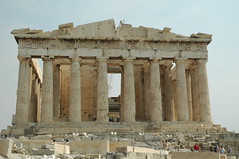On one sheet in your notebook-
1) Cut out a triangular paper roof support: a pediment. Decorate the pediment with a representation of battle scenes in the relief sculpture. Also make a smaller pediment to represent the rear of the building.
2) Cut and roll and glue the tiny paper columns; make at least 6.
3) Make a long, narrow rectangular piece to represent the frieze, the border along the edge of the roof.
4) Cut and fold a long, rectangular piece to represent the porch - or step - of the temple. Rituals were performed on the steps, acc to A History of the World.
5) Add a sketch of the 60-foot statue of Athena Parthenos (virgin), aka Pallas Athena. See more below.
6) Colorful hand-sketched map of the Aegean region, from Sparta - on the Peoloponnesus peninsula - to Athens, to Asia Minor to Crete, in the Mediterranean.
7) Sketch of the acropolis. Include the tiny temple of Athena Nike as well as the Parthenon. On the hillside of the acropolis is the Roman Amphitheater.
8) On the back: a 5-question, multiple-choice quiz based on the material on your project. A couple of easy ones, a couple of challenging questions. Please add the answers at the bottom of the page.
15 pts. / Thursday.
Athena was a deity of diverse functions and attributes, says Answers.com. Her most conspicuous role was perhaps that of a goddess of war, the female counterpart of Ares. However, she was also a goddess of peace, noted for her compassion and generosity. Like Minerva, with whom the Romans identified her, she was a patron of the arts and crafts, especially spinning and weaving. In later times she was important as a goddess of wisdom.
Athena was also a guardian of cities, notably Athens, where the Parthenon was erected as her temple. In a contest with Poseidon concerning dominion over Attica, Athena made an olive tree grow on the Acropolis while Poseidon caused a saltwater stream to gush from the Acropolis. The other Olympians, asked to judge the contest, decided in favor of Athena.
Her statue, the Palladium, was supposed to protect the city that possessed it. It was said that because she accidentally killed Pallas, she set the name Pallas before her own. Although a virgin goddess, she was concerned with fertility, and at Athens and Elis her worship was notably maternal. Athena is represented in art as a stately figure, armored, and wielding the aegis.
Tuesday, March 14, 2006
Subscribe to:
Post Comments (Atom)


No comments:
Post a Comment